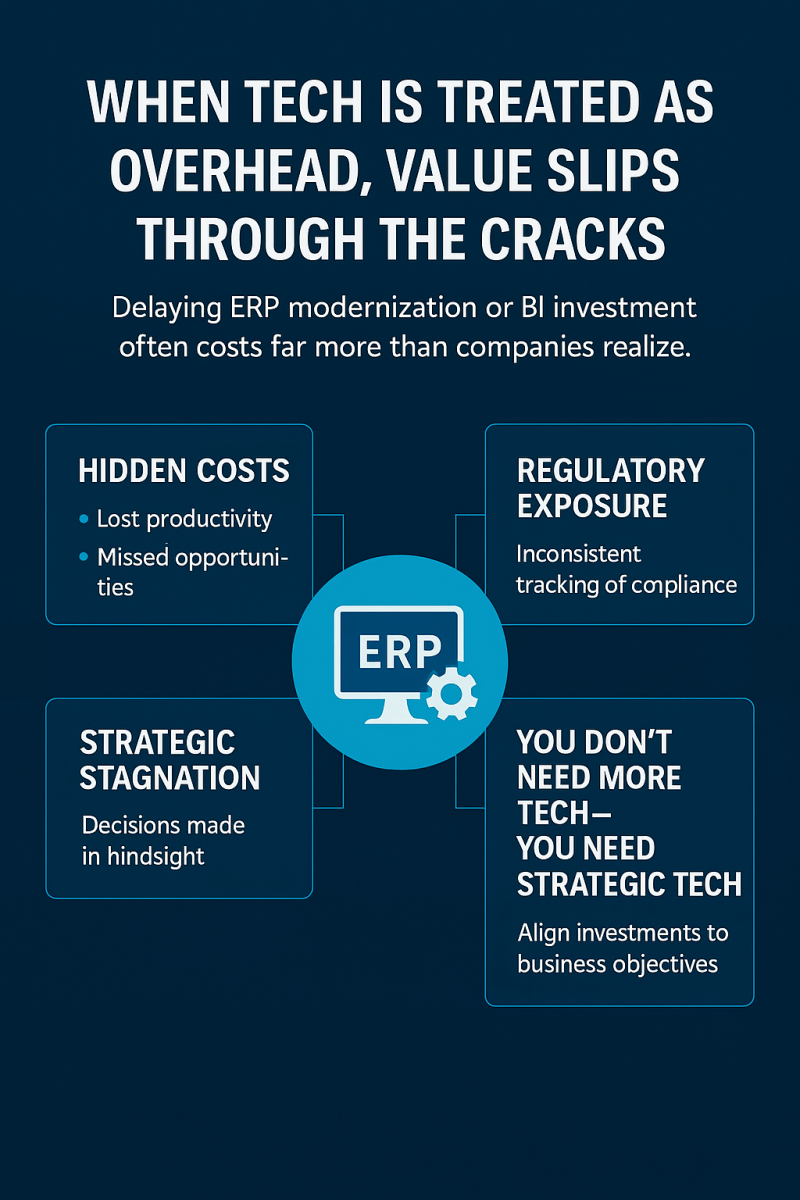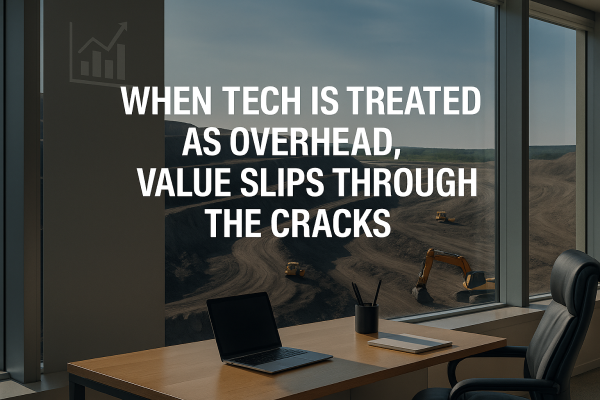In mining, oil & gas, and heavy equipment industries, legacy thinking persists in the boardroom. Technology is still viewed by many leaders not as a strategic driver—but as a cost to contain. ERP platforms, business intelligence tools, and digital analytics are relegated to the IT budget, lumped together with printers and patching. And that mindset? It's not just outdated—it’s quietly corrosive.
The High Cost of a Low-Tech Mindset
Every time a company delays upgrading its ERP, avoids integrating its data platforms, or hesitates on AI-enhanced reporting because “the ROI isn’t clear,” it pays a hidden tax: slower decisions, missed signals, duplicated effort, and uncontrolled risk. These aren’t theoretical downsides—they’re the operational drag that shows up as project delays, financial blind spots, and backlogs that never clear.
Consider this common scenario: A CFO struggles to consolidate financials from ten different entities because each site operates on a different system. Reports are late. Budgets are reactive. Worse, strategic capital planning becomes guesswork. Meanwhile, maintenance teams are using paper logs or spreadsheets, unable to access a unified history of asset performance. When a key piece of equipment fails, no one is surprised—but everyone is frustrated.
This is not about broken tools. It’s about broken framing. Technology, when treated as overhead, is starved of its strategic potential.
What Gets Framed Gets Funded
Boards routinely approve millions for new equipment, exploration licenses, or logistics upgrades—because the ROI is visible and immediate. But when the CIO requests funding to standardize ERP or implement predictive maintenance analytics, skepticism kicks in. Why? Because it’s seen as “IT cost,” not “performance enablement.”
The framing is the failure. When technology is positioned as an enabler—not an expense—it earns its place in board-level strategy. It becomes central to how the company grows, governs, and competes. In contrast, when it’s framed as overhead, it gets delayed, underfunded, and deprioritized—until the gap becomes too large to ignore.

People, Process, and Technology—Together or Not at All
Treating tech as overhead creates more than financial drag—it breaks alignment across the organization:
- People become disconnected from real-time insight. Decision-makers rely on instincts instead of data because they don’t trust the system—or worse, can’t access it. - Processes remain fragmented. One plant uses spreadsheets; another has siloed tools. There’s no standardization, no auditability, and no agility. - Technology is left to “support the business” rather than shape it.
In this fractured environment, even the most well-intentioned transformation efforts falter. You can’t build agility on top of fragmentation. You can’t scale excellence if the foundation is chaos.
The Price of Inaction
The companies that delay ERP modernization or BI investment are often trying to “save money.” But they end up paying far more in hidden costs:
- Lost productivity from duplicated effort and manual reconciliation
- Missed opportunities from slow response to market changes
- Regulatory exposure from inconsistent compliance tracking
- Strategic stagnation from decisions made in hindsight
And the competitive cost is even greater. In a world where digital-native competitors make decisions in minutes—not quarters—the lagging companies lose more than speed. They lose relevance.
You Don’t Need More Tech—You Need Strategic Tech
Technology is not the problem. Misunderstanding its purpose is. The goal isn’t to deploy more tools—it’s to choose and implement the right ones for the right reasons.
That starts by reframing tech as a strategic asset. ERP, for example, is not just a ledger system. It’s the nervous system of the modern industrial enterprise. When connected with real-time dashboards, AI-powered alerts, and automated workflows, it becomes the difference between reacting late and acting early.
From Overhead to Overdrive
The transformation begins when leadership changes the question from “What does it cost?” to “What value does it unlock?”
- Can we improve uptime by predicting failures before they happen?
- Can we reduce working capital by optimizing inventory with live data?
- Can we give our board real-time financial and operational insight instead of a rear-view mirror?
These are not IT questions. These are business strategy questions. And the answers shape not just budget line items—but enterprise performance.
Conclusion: Tech Strategy Is Business Strategy
In today’s risk-intensive, data-rich environment, viewing technology as overhead is a strategic liability. The cost is real—but the lost value is even greater.
The companies that lead tomorrow won’t be those with the most data—they’ll be the ones who use it best. That begins with reframing technology not as a cost center, but as a value engine—one that empowers people, streamlines processes, and redefines what’s possible.
The choice is simple: Treat technology as overhead—and get left behind. Or elevate it to its rightful place at the core of business strategy—and lead from the front.
